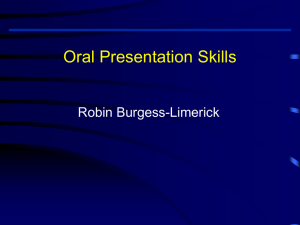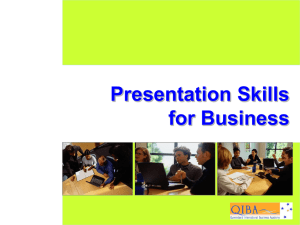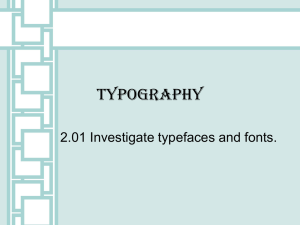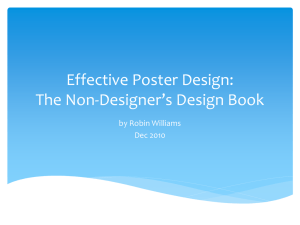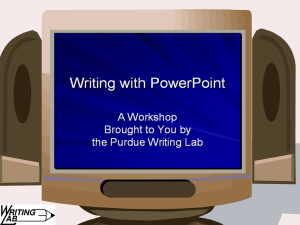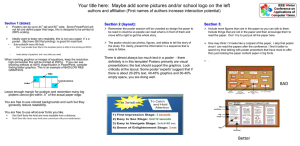Oral Presentation Skills
advertisement
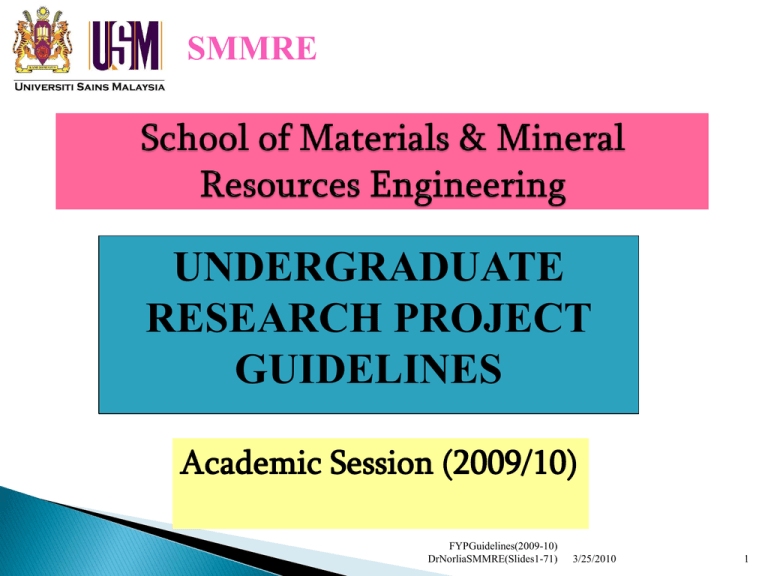
SMMRE UNDERGRADUATE RESEARCH PROJECT GUIDELINES Academic Session (2009/10) FYPGuidelines(2009-10) DrNorliaSMMRE(Slides1-71) 3/25/2010 1 SMMRE Prepared by Dr Norlia Baharun 25 Mac 2010 FYPGuidelines(2009-10) DrNorliaSMMRE(Slides1-71) 3/25/2010 2 The oral presentation is of 15 mins duration The next 5 mins will be on Q & A The oral presentation should be in the style of a scientific presentation: FYPGuidelines(2009-10) DrNorliaSMMRE(Slides1-71) 3/25/2010 3 INTRODUCTION STATEMENT OF OBJECTIVES SUMMARY OF METHODOLOGY PRESENTATION and INTERPRETATION OF RESULTS DISCUSSION OF RESULTS and THEIR BROADER IMPLICATIONS SUMMARY OF CONCLUSIONS or RECOMMENDATIONS FYPGuidelines(2009-10) DrNorliaSMMRE(Slides1-71) 3/25/2010 4 PROJECT CONTENT IS LARGELY MARKED IN THE WRITTEN REPORT THEREFORE, MARKS FOR ORAL PRESENTATION WILL FOCUS ON THE EFFECTIVENESS OF COMMUNICATION OF THE MAJOR FINDINGS OF THE PROJECT AND ON ABILITY TO RESPOND TO RELEVANT QUESTIONS FYPGuidelines(2009-10) DrNorliaSMMRE(Slides1-71) 3/25/2010 5 • Consider your audience • Anticipate opposing arguments • Make your audience feel something • Make your argument seem like common sense • Sound like you know what you’re talking about • Get the facts! FYPGuidelines(2009-10) DrNorliaSMMRE(Slides1-71) 3/25/2010 6 Created by Cindy Farnum • Have conviction • Save the strongest argument for last • Give examples and be specific • Give your paper a clear title • Avoid exaggeration • Give referrals • Read your audience’s body language FYPGuidelines(2009-10) DrNorliaSMMRE(Slides1-71) 3/25/2010 7 Created by Cindy Farnum Explain, interpret, justify, not just describe Write large (Fonts >24) Use color, but sparingly, consistently Use pictures (and even animations) No full sentences (just terse outline) Make the sub-story coherent and selfcontained One corollary: no standalone graphs FYPGuidelines(2009-10) DrNorliaSMMRE(Slides1-71) 3/25/2010 8 Talk Tips -Preparation Practice Dry run followed by slide-by-slide analysis Pay attention to time and practice for time Practice for varying audience backgrounds FYPGuidelines(2009-10) DrNorliaSMMRE(Slides1-71) 3/25/2010 9 Talk Tips –Presentation Speak clearly, make eye contact Don’t read slides Pay attention to posture Eye contact, shift gaze Plan on shedding slides Admit shortcomings, don’t wait for questions Analogies and jokes and help FYPGuidelines(2009-10) DrNorliaSMMRE(Slides1-71) 3/25/2010 10 Know your audience • Help them understand • Keep it short; use signposts; get the contents right. • Make sure you’ve covered the bases • (Leave some simple mistakes in?) FYPGuidelines(2009-10) DrNorliaSMMRE(Slides1-71) 3/25/2010 11 “Let’s see, what can I ask the candidate?” The examiners may have decided before the exam whether to pass you. Defense, viva, exam, ... viva = “viva voce” = “lively discussion” The exam is to check it’s your work... Talk fluently about the work; show you’ve thought about it (which you have!). ...and a chance to clarify things that aren’t clear in the thesis. FYPGuidelines(2009-10) DrNorliaSMMRE(Slides1-71) 3/25/2010 12 These are areas where corrections are likely. Know & understand your results. Fine-tune presentation Practice ! Practice ! Practice ! (esp. for grads) Know the literature you cited Anticipate possible questions, including implications of your results, the logic of your discussion, and relevance of your work. FYPGuidelines(2009-10) DrNorliaSMMRE(Slides1-71) 3/25/2010 13 What should you expect at the defense? • Could you fail? • Could it be one of life’s memorable events? • What are the characteristics of a great defense? • How do you get there? FYPGuidelines(2009-10) DrNorliaSMMRE(Slides1-71) 3/25/2010 14 • • Primarily a presentation of the thesis work: Like a (long) talk at a (small) conference But there are likely to be lots of questions Some possible goals of the defense are to: make sure you did it make sure you understand what you did make sure you understand the significance/context of what you did probe your general understanding of the field of the thesis make sure the committee understands what you did test your ability to present FYPGuidelines(2009-10) DrNorliaSMMRE(Slides1-71) 3/25/2010 15 FYPGuidelines(2009-10) DrNorliaSMMRE(Slides1-71) 3/25/2010 16 Giving an oral presentation is the final stage in the assessment of your Final Year Project Table 2.1 : Check List FYPGuidelines(2009-10) DrNorliaSMMRE(Slides1-71) 3/25/2010 17 List CONTENT Check List 1 Select Title of Project √ 2 Proposal Submitted √ 3 Experimental work carried out according to Plan √ 4 Final Draft submitted 9 April 2010 (14th academic week)- latest by 4 pm 5 Oral Presentation (viva) 10-13 May 2010 6. Final Thesis submission 21 May 2010 FYPGuidelines(2009-10) DrNorliaSMMRE(Slides1-71) 3/25/2010 18 SMMRE Students should develop : the ability to do scientific inquiry the understanding about scientific inquiry FYPGuidelines(2009-10) DrNorliaSMMRE(Slides1-71) 3/25/2010 20 Students must actively participate in scientific investigations and Students need to understand that experiments are guided by concepts and are performed to test ideas FYPGuidelines(2009-10) DrNorliaSMMRE(Slides1-71) 3/25/2010 21 SMMRE Students need to learn how to analyze evidence and data from scientific investigations or databases FYPGuidelines(2009-10) DrNorliaSMMRE(Slides1-71) 3/25/2010 22 Delivery of a speech – is easy Organization of a speech – is difficult FYPGuidelines(2009-10) DrNorliaSMMRE(Slides1-71) 3/25/2010 23 A. How to organize an oral presentation B. How to deliver FYPGuidelines(2009-10) DrNorliaSMMRE(Slides1-71) 3/25/2010 24 You must do four things: 1. 2. 3. 4. Make it short Make the organization obvious Make the ideas simple and vivid Summarize and be prepared for questions FYPGuidelines(2009-10) DrNorliaSMMRE(Slides1-71) 3/25/2010 25 You need to do only four things: 1. Set the stage and the audience 2. Have an insurance policy instead of a manuscript 3. Use visual aids 4. Talk loudly, slowly and vigorously FYPGuidelines(2009-10) DrNorliaSMMRE(Slides1-71) 3/25/2010 26 What explanation do you expect to develop from your data? How confident are you about the accuracy of your data? How certain are you of those results? Is there a better way to do the investigation ?? FYPGuidelines(2009-10) DrNorliaSMMRE(Slides1-71) 3/25/2010 27 Is there an alternative scientific explanation for the one you proposed? How do you account for an explanation that is different from others? Do you need more evidence? What are the sources of experimental error? FYPGuidelines(2009-10) DrNorliaSMMRE(Slides1-71) 3/25/2010 28 Questions like these makes it possible for students: - to analyze data - to develop a richer knowledge base - to reason using scientific concepts - to make connections between evidence and explanations and recognize alternative explanations FYPGuidelines(2009-10) DrNorliaSMMRE(Slides1-71) 3/25/2010 29 **Ideas should be examine and discuss with your supervisors FYPGuidelines(2009-10) DrNorliaSMMRE(Slides1-71) 3/25/2010 30 SMMRE FYPGuidelines(2009-10) DrNorliaSMMRE(Slides1-71) 3/25/2010 31 Your mental set Preparation The presentation Your delivery Question time Visual aids Conclusions FYPGuidelines(2009-10) DrNorliaSMMRE(Slides1-71) 3/25/2010 32 Imagine that you’re simply having a conversation Ways to keep calm ?? If you’re really bad, try meditation and muscle relaxation. Imagine yourself giving a good confident presentation. Practise in front of a friend. FYPGuidelines(2009-10) DrNorliaSMMRE(Slides1-71) 3/25/2010 33 Background research – use wide range of sources Personal organization Do preparation well in advance FYPGuidelines(2009-10) DrNorliaSMMRE(Slides1-71) 3/25/2010 34 What is the purpose? Inform, show progress, persuade, entertain? What are the objectives of the talk? Have in mind your goal. eg. to explain a particular topic in general terms FYPGuidelines(2009-10) DrNorliaSMMRE(Slides1-71) 3/25/2010 35 What are the main points? Concentrate on what is really important. Don’t be over-ambitious. There is a time limit and a limit to what people can be taken in. Cue cards suits some people. Should just have key words, not the text. Postcard size. Number them. FYPGuidelines(2009-10) DrNorliaSMMRE(Slides1-71) 3/25/2010 36 Format? Debate, conversation with audience, lecture? Practise. To build confidence. Need full-scale rehearsal for timing. Consider your audience. Present state of knowledge? Write out first draft. Review this and take out irrelevant material. Consistent? Flows smoothly? Don’t try to learn verbatim. FYPGuidelines(2009-10) DrNorliaSMMRE(Slides1-71) 3/25/2010 37 Title: Give the title and stick to it. Dramatise. Find a memorable way to get point across. Be positive. Maintain the appearance of being confident. Structured. Make presentation structured. (see next) FYPGuidelines(2009-10) DrNorliaSMMRE(Slides1-71) 3/25/2010 38 Example: 1. State main issue or problem. 2. Give examples to illustrate. 3. End with a summary. 4. Handle questions. 5. Make a final statement. FYPGuidelines(2009-10) DrNorliaSMMRE(Slides1-71) 3/25/2010 39 Introduction: Explain the outline and structure and the aims of the talk. Main part: Explain the main project with supporting information. Explain any complicated terms. Conclusions: Remind the audience of the subject area and the focus of the presentation. Try to tell an interesting project . FYPGuidelines(2009-10) DrNorliaSMMRE(Slides1-71) 3/25/2010 40 Use specific examples if theoretical or abstract. Use linking statements. Use visual aids. Use brief summaries at appropriate points. Don’t preach. FYPGuidelines(2009-10) DrNorliaSMMRE(Slides1-71) 3/25/2010 41 Write for the ear, not the eye. We don’t speak the way we write. Sentences will be shorter and punchier. Avoid long words, or words that you’re going to find difficult to pronounce. Tape recording. Listen to your rehearsed talk without notes. Flows logically? Voice and pace not monotonous? FYPGuidelines(2009-10) DrNorliaSMMRE(Slides1-71) 3/25/2010 42 Pace: Don’t speak too rapidly. Neither speak deliberately slowly. If you speak naturally, pace should be OK. Timing: Keep to time limit. Pause at key points. Don’t read from a script. This can sound boring. At the very least, don’t sound as if you’re reading. Eye contact. Connected to last point – look around at audience when possible. FYPGuidelines(2009-10) DrNorliaSMMRE(Slides1-71) 3/25/2010 43 Voice. Vary the tone and the pace (slightly). How you say it is important. Don’t shout or whisper. If using a mike, ask the back if they can hear. Articulation. Don’t slur your speech, making it more difficult to hear. Avoid repeated phrases. “you know”, etc. Smile and be confident. FYPGuidelines(2009-10) DrNorliaSMMRE(Slides1-71) 3/25/2010 44 Mobility. Try not to walk around. Don’t sit down. Some animation is desirable. Don’t slouch or lean on the wall. Avoid distractions, e.g. gum chewing. Don’t digress. Difficult to get back on track afterwards. FYPGuidelines(2009-10) DrNorliaSMMRE(Slides1-71) 3/25/2010 45 Depend on time available Listen carefully. Rephrase difficult questions. To clarify understanding. Take time to consider. OK to say “I don’t know”. Reply to whole audience. Don’t take hostile questions personally and don’t be hostile in tone when answering questions (or asking questions of others). FYPGuidelines(2009-10) DrNorliaSMMRE(Slides1-71) 3/25/2010 46 Be careful of colour. Colour on an OHP can be too faint (esp orange and yellow). Font size. 16-18-point Times Roman is recommended. DON’T USE CAPITALS. Don’t try to cram too much in. Leave on long enough to read. Put on your key points. Supplement or explain what is meant by these headings. Uncover points one-by-one? FYPGuidelines(2009-10) DrNorliaSMMRE(Slides1-71) 3/25/2010 47 Figures. Useful for holding interest. Pointing. Easier to point on an overhead than screen. Avoid too much room light near screen. But don’t plunge audience in darkness. Stand so that not in the way of screen. Number slides in case you mix them up. FYPGuidelines(2009-10) DrNorliaSMMRE(Slides1-71) 3/25/2010 48 Keep calm and be positive. Rehearsal can help out with timing. Tape recording even better. What are your main points? Be concise, focussed and well structured. Linkages. Keep it flowing well. Pace. Be natural and keep to the required time. Overheads. Try not to cram too much in. Keep to main headings Questions. Answer them carefully. FYPGuidelines(2009-10) DrNorliaSMMRE(Slides1-71) 3/25/2010 49 OUTLINE Planning Preparation Practice Performance Questions Who are you talking to? Why are you talking to them? How long have you got? What findings are you going to tell? • • • • Outline and sketch slides Prepare slides Proof read Prepare notes brief keywords and phrases, except maybe first couple of paragraphs 1 - 2 minutes per slide Generic 15 min Conference Presentation Title Slide (1) Title, author, affiliation, acknowledgements Rationale (1-2) Why this is interesting Methods (1-2) What you did Results (2-4) What did you find and what does it mean Summary (1) One thing you want them to remember Use Images & Graphics Minimise text & numbers Light text on dark background Avoid distracting backgrounds Use large sans serif fonts Helvetica or Arial rather than serif fonts like Times 24 pt is minimum, 32 pt, or even 36 pt is better Use Images & Graphics Minimise text & numbers Light text on dark background Avoid distracting backgrounds Use large sans serif fonts Mix upper and lower case ALL CAPITALS IS HARDER TO READ, ALTHOUGH IT MIGHT BE OK FOR THE ODD TITLE Use Images & Graphics Minimise text & numbers Light text on dark background Avoid distracting backgrounds Use large sans serif fonts Mix upper and lower case Use colour to highlight text Use high contrast colours for important lines, symbols or text, and lower contrast colours for less important lines, symbols or text. But use a small number of colours Use Images & Graphics Minimise text & numbers Light text on dark background Avoid distracting backgrounds Use large sans serif fonts Mixture upper and lower case Use colour to highlight text Keep figures simple Show means, sd, effect size statistics, but not test statistics Y axis (units) 80 * 60 40 20 0 1 2 3 4 5 Condition 6 7 8 Use Images & Graphics Minimise text & numbers Light text on dark background Avoid distracting backgrounds Use large sans serif fonts Mixture upper and lower case Use colour to highlight text Keep figures simple Thick lines and large symbols 20 Y Axis (units) r = 0.89 15 10 Participant 2 5 0 20 30 40 50 60 X Axis (units) 70 Use Images & Graphics Minimise text & numbers Light text on dark background Avoid distracting backgrounds Use large sans serif fonts Mixture upper and lower case Use colour to highlight text Keep figures simple Thick lines and large symbols Progressive disclosure • • • Practice, practice, practice Get feedback, and use it. Be ruthless – delete unnecessary information • Don’t • • • • Apologise Speak loudly & clearly Use short simple sentences Avoid jargon & abbrev. Vary pitch, tone, volume, speed and pauses • • • • Avoid distracting mannerisms Relax, be enthusiastic Make eye contact Keep an eye on the time remaining • Explain figures, and point to important aspects • Give a clear and concise summary, then stop. • Don’t go over the time. Ever. • Anticipate likely questions and prepare extra slides with the answers • Maybe even plant a stooge Paraphrase questions 1. so that other people hear the question 2. to check that you understand the questions 3. to stall while you think about an answer • • • If you don’t know the answer, say so. Offer to find out. Ask the audience. Like most things, the best way to learn is to do FYPGuidelines(2009-10) DrNorliaSMMRE(Slides1-71) 3/25/2010 70 FYPGuidelines(2009-10) DrNorliaSMMRE(Slides1-71) 3/25/2010 71
